管理咨询案例分析:耐克“血汗工厂”事件
- 格式:doc
- 大小:0.77 KB
- 文档页数:1
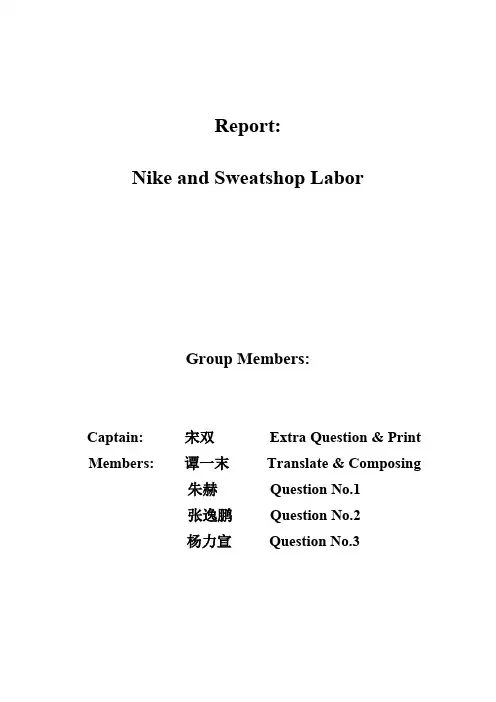
Report:Nike and Sweatshop LaborGroup Members:Captain: 宋双Extra Question & Print Members: 谭一末Translate & Composing朱赫Question No.1张逸鹏Question No.2杨力宣Question No.3Nike and Sweatshop LaborNike, a company headquartered in Beaverton, Oregon, is a major force in the sports footwear and fashion industry, with annual sales exceeding $12 billion, more than half of which now come from outside the United States. The company was co-founded in 1964 by Phil Knight, a CPA at Price Waterhouse, and Bill Bowerman, college track coach, each investing $500 to start. The company, initially called Blue Ribbon Sports, changed its name to Nike in 1971 and adopted the “Swoosh” logo-recognizable around the world-originally designed by a college student for $35. Nike became highly successful in designing and marketing mass-appealing products such as the Air Jordan, the best selling athletic shoe of all time.Nike has no production facilities in the United States. Rather, the company manufactures athletic shoes and garments in such Asian countries as China, Indonesia, and Vietnam using subcontractors, and sells the products in the U.S. and international markets. In each of those Asian countries where Nike has production facilities, the rates of unemployment and under-employment are quite high. The wage rate is very low in those countries by U.S. standards-the hourly wage rate in the manufacturing sector is less than $1 in each of those countries, compares with about $20 in the United States. In addition, workers in those countries often operate in poor and unhealthy environments and their rights are not particularly well protected. Understandably, host countries are eager to attract foreign investments like Nike’s to develop their economies and raise the living standards of their citizens. Recently, however, Nike came under worldwide criticism for its practice of hiring workers for such a low rate of pay-“next to nothing” in the words of critics-and condoning poor working conditions in host countries.Initially, Nike denied the sweatshop charges and lashed out at critics. But later, the company began monitoring the labor practices at its overseas factories and grading the factories in order to improve labor standards. Nike also agreed to random factory inspections by disinterested parties.Do you think the criticism of Nike is fair, considering that the host countries are in dire needs of creating jobs?Obviously, Nike’s investments in such Asian countries as China, Indonesia, and Vietnam were motivated to take advantage of low labor costs in those countries. While Nike was criticized for the poor working conditions for its workers, the company has recognized the problem and has substantially improved the working environments recently. Although Nike’s workers get paid very low wages by the Western standard, they probably are making substantially more than their local compatriots who are either under- or unemployed. While Nike’s detractors may have valid points, one should not ignore the fact that the company is making contributions to the economic welfare of those Asian countries by creating job opportunities.What do you think Nike’s executives might have done differently to prevent the sensitive charges of sweatshop labor in overseas factories?Internal operation:•Improve the working condition, increase employees’ income and raise the minimum employment age;External operations:•Public Relationship: Nike should invite some social figures who at least hold moderate attitude towards this issue to inspect their factories and makeadvantageous comments on it;•OEM Standard: The so-called “sweat factory” refers to OEMs instead of Nike headquarter. Nike is only responsible for designing and selling shoes,and outsourcers the parts production and assembly work to OEMs. Nike mayset some standards to OEMs on payments and working conditions, etc. Onlythose who have met the standards can cooperate with Nike;•Corporate Image: Nike can promote their positive popularity and improve their image by subsidizing schools and other NGOs, as well as taking part inmore charity activities for the sake of reducing the bad influence on this issue.Do firms need to consider the co-called corporate social responsibilities in making in investment decisions?Yes. Because “corporate social responsibilities” are not only aiming at maximizing the profit of shareholders, but also in charge of caring and increasing other social interests at the maximum extent, including interests of consumers, employees, creditor, small and medium-sized competitors, local communities, environment, so long as the total social public interests, and so forth. So that as a globally reputed enterprise, Nike not only has to consider their profits, but also take their social obligations into consideration when it is going to make investment decisions. Nike should care about other social interests, especially of those exploited overseas workers. By taking these steps, Nike would response to the questions, establish positive image and take their social responsibilities.Extra Question:What’re the advantages and disadvantages to those cheap-labor countries like China that MNC set their factory in their countries?Advantages:•Increase capital for these countries and partial interests for governments;•Boost employment opportunities and tax revenue.Disadvantages:•Bring competition to the local corporations;•Exploit local labor.。

苹果公司血汗工厂的案例分析关于血汗工厂的案例分析案例截止2011年12月,苹果公司的销售额大涨73%,至436美元,利润则翻了一倍多,至131亿美元,这一业绩使得苹果的现金储备达到了976亿美元。
苹果公司在业绩上成为了当之无愧的销售之王,但同时,它还有另一个名字:血汗工厂。
众所周知,苹果本身不设工厂,而是通过招收供应商的方式生产产品。
这些法律上受苹果公司一定程度管制的工厂却被外界称为“血汗工厂”,因为苹果的每一个产品都是建立在工人的血汗之上的。
包括每日超过10小时的工作时间,恶劣的工作环境,繁重的工作任务,导致工人如机器般生活着。
这些情况直接导致了富士康10连跳事件和137名工人因用有毒的正己烷清洁IPone屏幕使神经系统受到损伤,以及在2011年7月,两家制造iPad 的工厂发生了类似的铝粉爆炸事件,导致4人遇难,77人受伤。
这些把生命压低到生产线之下的现象持续存在着,而供应商与苹果公司却都没有彻底整改的意思。
对于供应商而言,每年世界各地工厂负责人都会飞往苹果公司总部或者邀请苹果高层来工厂参观以展现其高效的生产线、先进的生产设备,只为获得苹果高额的合同单。
对于苹果公司而言,一旦因为整改工人工作环境而与核心供应商发生冲突,可能会影响到新产品出工的速度,从而威胁其竞争优势,因此苹果给出的回应总是:我们只是在遵守当地的规定。
理论对于企业而言,其目标是运用有限的资本,通过生产经营活动,以取得最大的利润。
利润是收益减去成本,成本是指商品生产活动中所使用的生产要素的价值。
成本又分为固定成本和可变成本,可变成本指企业短时期为可以改变的那些可变投入要素所带来的成本,通常包括工人工资、原材料成本等。
可变成本越低,成本越低,利润越大。
故压低成本是企业获取巨额利润的有效途径之一。
案例分析在上述案例中,工人权益与企业利益形成了矛盾。
要具体分析血汗工厂存在的原因,需从苹果公司与代工工厂两个角度看待问题。
通过代工工厂,苹果一年能省下多少成本?以富士康工厂为例,一名大专毕业的工人工资为22美元,含加班费,一天工作12小时,而一位美国工人,一天工作8小时,每小时工资为8美元。
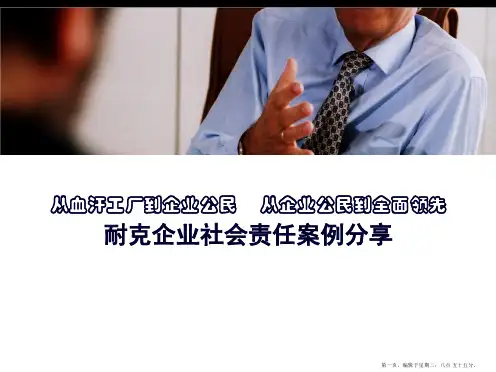
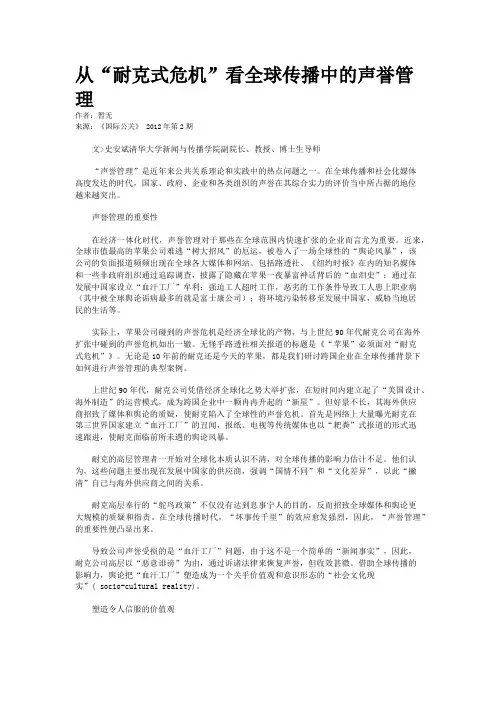
从“耐克式危机”看全球传播中的声誉管理作者:暂无来源:《国际公关》 2012年第2期文>史安斌清华大学新闻与传播学院副院长、教授、博士生导师“声誉管理”是近年来公共关系理论和实践中的热点问题之一。
在全球传播和社会化媒体高度发达的时代,国家、政府、企业和各类组织的声誉在其综合实力的评价当中所占据的地位越来越突出。
声誉管理的重要性在经济一体化时代,声誉管理对于那些在全球范围内快速扩张的企业而言尤为重要。
近来,全球市值最高的苹果公司难逃“树大招风”的厄运,被卷入了一场全球性的“舆论风暴”,该公司的负面报道频频出现在全球各大媒体和网站。
包括路透社、《纽约时报》在内的知名媒体和一些非政府组织通过追踪调查,披露了隐藏在苹果一夜暴富神话背后的“血泪史”:通过在发展中国家设立“血汗工厂”牟利;强迫工人超时工作,恶劣的工作条件导致工人患上职业病(其中被全球舆论诟病最多的就是富士康公司);将环境污染转移至发展中国家,威胁当地居民的生活等。
实际上,苹果公司碰到的声誉危机是经济全球化的产物,与上世纪90年代耐克公司在海外扩张中碰到的声誉危机如出一辙。
无怪乎路透社相关报道的标题是《“苹果”必须面对“耐克式危机”》。
无论是10年前的耐克还是今天的苹果,都是我们研讨跨国企业在全球传播背景下如何进行声誉管理的典型案例。
上世纪90年代,耐克公司凭借经济全球化之势大举扩张,在短时间内建立起了“美国设计、海外制造”的运营模式,成为跨国企业中一颗冉冉升起的“新星”。
但好景不长,其海外供应商招致了媒体和舆论的质疑,使耐克陷入了全球性的声誉危机。
首先是网络上大量曝光耐克在第三世界国家建立“血汗工厂”的丑闻,报纸、电视等传统媒体也以“耙粪”式报道的形式迅速跟进,使耐克面临前所未遇的舆论风暴。
耐克的高层管理者一开始对全球化本质认识不清,对全球传播的影响力估计不足。
他们认为,这些问题主要出现在发展中国家的供应商,强调“国情不同”和“文化差异”,以此“撇清”自己与海外供应商之间的关系。
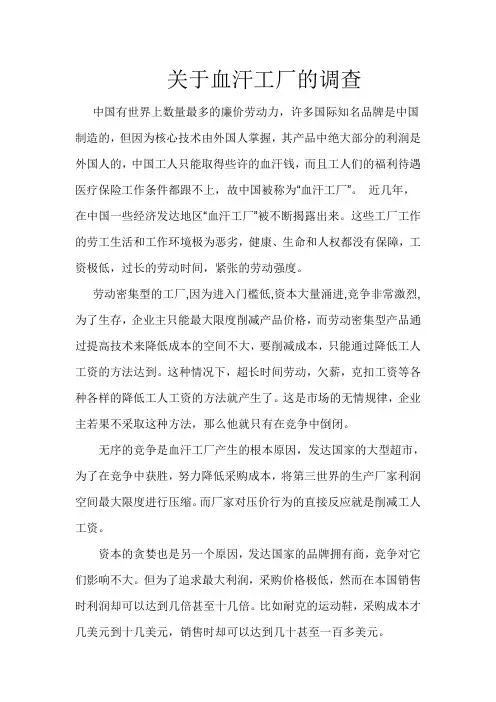
关于血汗工厂的调查中国有世界上数量最多的廉价劳动力,许多国际知名品牌是中国制造的,但因为核心技术由外国人掌握,其产品中绝大部分的利润是外国人的,中国工人只能取得些许的血汗钱,而且工人们的福利待遇医疗保险工作条件都跟不上,故中国被称为“血汗工厂”。
近几年,在中国一些经济发达地区“血汗工厂”被不断揭露出来。
这些工厂工作的劳工生活和工作环境极为恶劣,健康、生命和人权都没有保障,工资极低,过长的劳动时间,紧张的劳动强度。
劳动密集型的工厂,因为进入门槛低,资本大量涌进,竞争非常激烈,为了生存,企业主只能最大限度削减产品价格,而劳动密集型产品通过提高技术来降低成本的空间不大,要削减成本,只能通过降低工人工资的方法达到。
这种情况下,超长时间劳动,欠薪,克扣工资等各种各样的降低工人工资的方法就产生了。
这是市场的无情规律,企业主若果不采取这种方法,那么他就只有在竞争中倒闭。
无序的竞争是血汗工厂产生的根本原因,发达国家的大型超市,为了在竞争中获胜,努力降低采购成本,将第三世界的生产厂家利润空间最大限度进行压缩。
而厂家对压价行为的直接反应就是削减工人工资。
资本的贪婪也是另一个原因,发达国家的品牌拥有商,竞争对它们影响不大。
但为了追求最大利润,采购价格极低,然而在本国销售时利润却可以达到几倍甚至十几倍。
比如耐克的运动鞋,采购成本才几美元到十几美元,销售时却可以达到几十甚至一百多美元。
58.82%的同学认为有关部门的不作为导致了血汗工厂的产生,对此有关部门应负主要责任,41.18%的被调查者认为代工厂应负主要责任。
从调查中我们可以看到,网友们都认为是这两方应为此类事件负全责。
血汗工厂中包含的马克思主义的经济原理剩余价值在私有经济的资本家面前就是一切,只要有私营经济存在,人的本性决定一个人从普通人转而成为资本家后就产生了质的变化,这是人的劣根性使然,这在任何社会制度下都一样,剥削的程度取决于社会的腐败程度.工人的工作时间长,工资待遇低,拖欠和克扣工资现象严重,工作条件非常差等等。

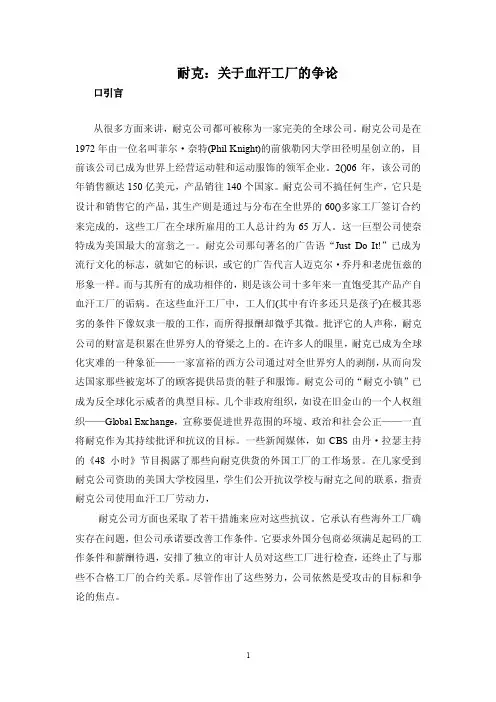
耐克:关于血汗工厂的争论口引言从很多方面来讲,耐克公司都可被称为一家完美的全球公司。
耐克公司是在1972年由一位名叫菲尔·奈特(Phil Knight)的前俄勒冈大学田径明星创立的,目前该公司已成为世界上经营运动鞋和运动服饰的领军企业。
2()06年,该公司的年销售额达150亿美元,产品销往140个国家。
耐克公司不搞任何生产,它只是设计和销售它的产品,其生产则是通过与分布在全世界的60()多家工厂签订合约来完成的,这些工厂在全球所雇用的工人总计约为65万人。
这一巨型公司使奈特成为美国最大的富翁之一。
耐克公司那句著名的广告语“Just Do It!”已成为流行文化的标志,就如它的标识,或它的广告代言人迈克尔·乔丹和老虎伍兹的形象一样。
而与其所有的成功相伴的,则是该公司十多年来一直饱受其产品产自血汗工厂的诟病。
在这些血汗工厂中,工人们(其中有许多还只是孩子)在极其恶劣的条件下像奴隶一般的工作,而所得报酬却微乎其微。
批评它的人声称,耐克公司的财富是积累在世界穷人的脊梁之上的。
在许多人的眼里,耐克已成为全球化灾难的一种象征——一家富裕的西方公司通过对全世界穷人的剥削,从而向发达国家那些被宠坏了的顾客提供昂贵的鞋子和服饰。
耐克公司的“耐克小镇”已成为反全球化示威者的典型目标。
几个非政府组织,如设在旧金山的一个人权组织——Global Exchange,宣称要促进世界范围的环境、政治和社会公正——一直将耐克作为其持续批评和抗议的目标。
一些新闻媒体,如CBS由丹·拉瑟主持的《48小时》节目揭露了那些向耐克供货的外国工厂的工作场景。
在几家受到耐克公司资助的美国大学校园里,学生们公开抗议学校与耐克之间的联系,指责耐克公司使用血汗工厂劳动力,耐克公司方面也采取了若干措施来应对这些抗议。
它承认有些海外工厂确实存在问题,但公司承诺要改善工作条件。
它要求外国分包商必须满足起码的工作条件和薪酬待遇,安排了独立的审计人员对这些工厂进行检查,还终止了与那些不合格工厂的合约关系。
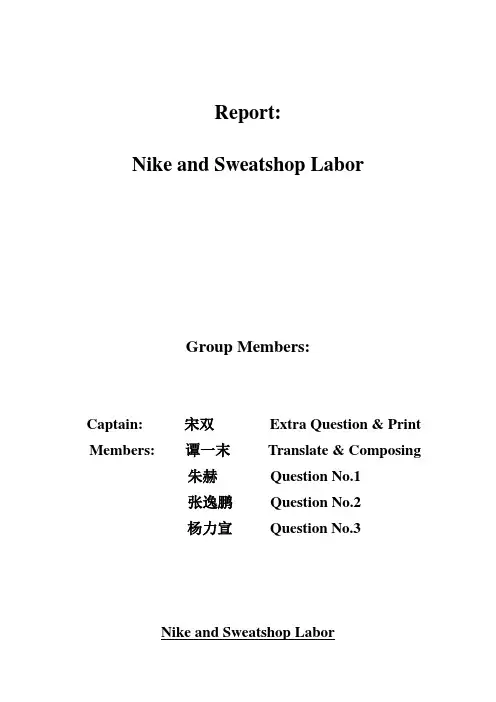
Report:Nike and Sweatshop LaborGroup Members:Captain: 宋双Extra Question & Print Members: 谭一末Translate & Composing朱赫Question No.1张逸鹏Question No.2杨力宣Question No.3Nike and Sweatshop LaborNike, a company headquartered in Beaverton, Oregon, is a major force in the sports footwear and fashion industry, with annual sales exceeding $12 billion, more than half of which now come from outside the United States. The company was co-founded in 1964 by Phil Knight, a CPA at Price Waterhouse, and Bill Bowerman, college track coach, each investing $500 to start. The company, initially called Blue Ribbon Sports, changed its name to Nike in 1971 and adopted the “Swoosh”logo-recognizable around the world-originally designed by a college student for $35. Nike became highly successful in designing and marketing mass-appealing products such as the Air Jordan, the best selling athletic shoe of all time.Nike has no production facilities in the United States. Rather, the company manufactures athletic shoes and garments in such Asian countries as China, Indonesia, and Vietnam using subcontractors, and sells the products in the U.S. and international markets. In each of those Asian countries where Nike has production facilities, the rates of unemployment and under-employment are quite high. The wage rate is very low in those countries by U.S. standards-the hourly wage rate in the manufacturing sector is less than $1 in each of those countries, compares with about $20 in the United States. In addition, workers in those countries often operate in poor and unhealthy environments and their rights are not particularly well protected. Understandably, host countries are eager to attract foreign investments like Nike’s to develop their economies and raise the living standards of their citizens. Recently, however, Nike came under worldwide criticism for its practice of hiring workers for such a low rate of pay-“next to nothing” in the words of critics-and condoning poor working conditions in host countries.Initially, Nike denied the sweatshop charges and lashed out at critics. But later, the company began monitoring the labor practices at its overseas factories and grading the factories in order to improve labor standards. Nike also agreed to random factory inspections by disinterested parties.Discussion Points:Do you think the criticism of Nike is fair, considering that the host countries are in dire needs of creating jobs?Obviously, Nike’s investments in such Asian countries as China, Indonesia, and Vietnam were motivated to take advantage of low labor costs in those countries. While Nike was criticized for the poor working conditions for its workers, the company has recognized the problem and has substantially improved the working environments recently. Although Nike’s workers get paid very low wages by the Western standard, they probably are making substantially more than their local compatriots who are either under- or unemployed. While Nike’s detractors may have valid points, one should not ignore the fact that the company is making contributions to the economic welfare of those Asian countries by creating job opportunities.Discussion Points:What do you think Nike’s executives might have done differently to prevent the sensitive charges of sweatshop labor in overseas factories?➢Internal operation:•Improve the working condition, increase employees’income and raise the minimum employment age;➢External operations:•Public Relationship: Nike should invite some social figures who at least hold moderate attitude towards this issue to inspect their factories and makeadvantageous comments on it;•OEM Standard: The so-called “sweat factory”refers to OEMs instead of Nike headquarter. Nike is only responsible for designing and selling shoes,and outsourcers the parts production and assembly work to OEMs. Nike mayset some standards to OEMs on payments and working conditions, etc. Onlythose who have met the standards can cooperate with Nike;•Corporate Image: Nike can promote their positive popularity and improve their image by subsidizing schools and other NGOs, as well as taking part inmore charity activities for the sake of reducing the bad influence on thisissue.Discussion Points:Do firms need to consider the co-called corporate social responsibilities in making in investment decisions?Yes. Because “corporate social responsibilities” are not only aiming at maximizing the profit of shareholders, but also in charge of caring and increasing other social interests at the maximum extent, including interests of consumers, employees, creditor, small and medium-sized competitors, local communities, environment, so long as the total social public interests, and so forth. So that as a globally reputed enterprise, Nike not only has to consider their profits, but also take their social obligations into consideration when it is going to make investment decisions. Nike should care about other social interests, especially of those exploited overseas workers. By taking these steps, Nike would response to the questions, establish positive image and take their social responsibilities.Extra Question:What’re the advantages and disadvantages to those cheap-labor countries like China that MNC set their factory in their countries?➢Advantages:•Increase capital for these countries and partial interests for governments;•Boost employment opportunities and tax revenue.➢Disadvantages:•Bring competition to the local corporations;。
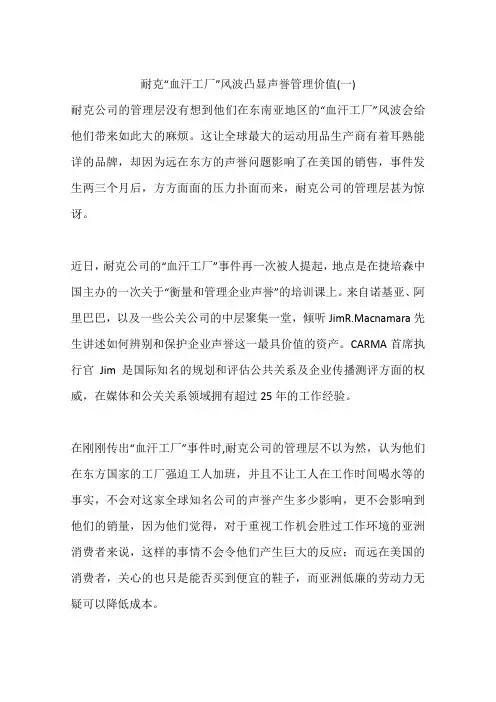
耐克“血汗工厂”风波凸显声誉管理价值(一)耐克公司的管理层没有想到他们在东南亚地区的“血汗工厂”风波会给他们带来如此大的麻烦。
这让全球最大的运动用品生产商有着耳熟能详的品牌,却因为远在东方的声誉问题影响了在美国的销售,事件发生两三个月后,方方面面的压力扑面而来,耐克公司的管理层甚为惊讶。
近日,耐克公司的“血汗工厂”事件再一次被人提起,地点是在捷培森中国主办的一次关于“衡量和管理企业声誉”的培训课上。
来自诺基亚、阿里巴巴,以及一些公关公司的中层聚集一堂,倾听JimR.Macnamara先生讲述如何辨别和保护企业声誉这一最具价值的资产。
CARMA首席执行官Jim是国际知名的规划和评估公共关系及企业传播测评方面的权威,在媒体和公关关系领域拥有超过25年的工作经验。
在刚刚传出“血汗工厂”事件时,耐克公司的管理层不以为然,认为他们在东方国家的工厂强迫工人加班,并且不让工人在工作时间喝水等的事实,不会对这家全球知名公司的声誉产生多少影响,更不会影响到他们的销量,因为他们觉得,对于重视工作机会胜过工作环境的亚洲消费者来说,这样的事情不会令他们产生巨大的反应;而远在美国的消费者,关心的也只是能否买到便宜的鞋子,而亚洲低廉的劳动力无疑可以降低成本。
然而事实却远远超过了他们的想象,耐克的员工开始担心在给一个非常不道德的公司打工,美国的消费者也开始上街游行,声称他们不只愿买便宜的鞋子,也会买贵的鞋子,甚至美国的非政府组织、工会也纷纷赶来“凑热闹”,借机要求耐克关闭在亚洲的工厂,因为很多美国人因此丢了工作。
于是在两三个月后,耐克的管理层像是猛然惊醒过来,开始派高层来亚洲沟通。
JimR.Macnamara先生提到了耐克“血汗工厂”的例子,是为了强调企业声誉的重要性,即使是对一个国际知名品牌来说。
在他看来,企业的声誉和品牌还是有明显区别的,而他对如何管理和维护企业的声誉也有一套自己独到的见解。
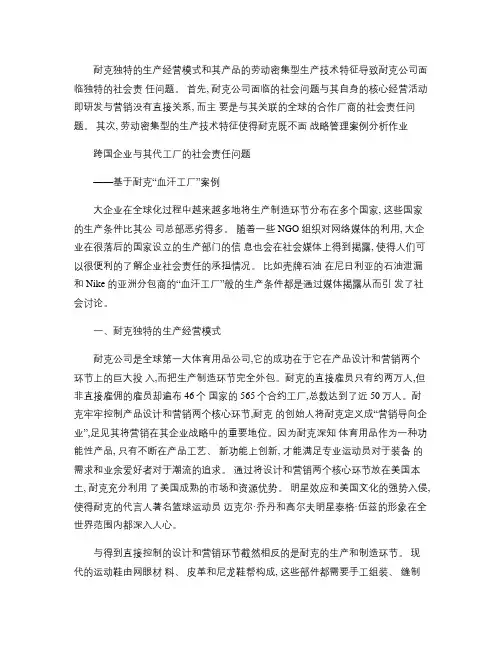
耐克独特的生产经营模式和其产品的劳动密集型生产技术特征导致耐克公司面临独特的社会责任问题。
首先, 耐克公司面临的社会问题与其自身的核心经营活动即研发与营销没有直接关系, 而主要是与其关联的全球的合作厂商的社会责任问题。
其次, 劳动密集型的生产技术特征使得耐克既不面战略管理案例分析作业跨国企业与其代工厂的社会责任问题——基于耐克“血汗工厂”案例大企业在全球化过程中越来越多地将生产制造环节分布在多个国家, 这些国家的生产条件比其公司总部恶劣得多。
随着一些 NGO 组织对网络媒体的利用, 大企业在很落后的国家设立的生产部门的信息也会在社会媒体上得到揭露, 使得人们可以很便利的了解企业社会责任的承担情况。
比如壳牌石油在尼日利亚的石油泄漏和 Nike 的亚洲分包商的“血汗工厂”般的生产条件都是通过媒体揭露从而引发了社会讨论。
一、耐克独特的生产经营模式耐克公司是全球第一大体育用品公司,它的成功在于它在产品设计和营销两个环节上的巨大投入,而把生产制造环节完全外包。
耐克的直接雇员只有约两万人,但非直接雇佣的雇员却遍布 46个国家的 565个合约工厂,总数达到了近 50万人。
耐克牢牢控制产品设计和营销两个核心环节,耐克的创始人将耐克定义成“营销导向企业”,足见其将营销在其企业战略中的重要地位。
因为耐克深知体育用品作为一种功能性产品, 只有不断在产品工艺、新功能上创新, 才能满足专业运动员对于装备的需求和业余爱好者对于潮流的追求。
通过将设计和营销两个核心环节放在美国本土, 耐克充分利用了美国成熟的市场和资源优势。
明星效应和美国文化的强势入侵, 使得耐克的代言人著名篮球运动员迈克尔·乔丹和高尔夫明星泰格·伍兹的形象在全世界范围内都深入人心。
与得到直接控制的设计和营销环节截然相反的是耐克的生产和制造环节。
现代的运动鞋由网眼材料、皮革和尼龙鞋帮构成, 这些部件都需要手工组装、缝制并用胶水粘合才能组成一双万丈的运动鞋。
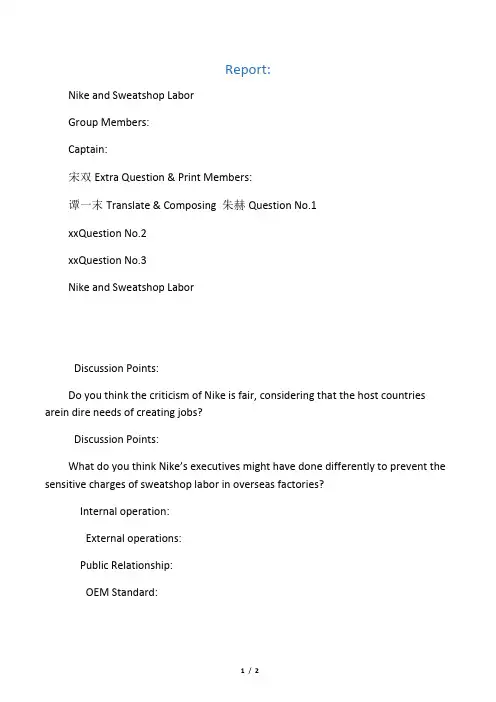
Report:Nike and Sweatshop LaborGroup Members:Captain:宋双Extra Question & Print Members:谭一末Translate & Composing 朱赫Question No.1xxQuestion No.2xxQuestion No.3Nike and Sweatshop LaborDiscussion Points:Do you think the criticism of Nike is fair, considering that the host countries arein dire needs of creating jobs?Discussion Points:What do you think Nike’s executives might have done differently to prev ent the sensitive charges of sweatshop labor in overseas factories?Internal operation:External operations:Public Relationship:OEM Standard:The so-called “sweat factory”refers to OEMs instead of Nike headquarter.Nike is only responsible for designing and selling shoes,and outsourcers the parts production and assembly work to OEMs. Nike may set some standards to OEMs on payments and working conditions, etc. Only those who have met the standards can cooperate with Nike;Corporate Image:Nike can promote their positive popularity and improve their image by subsidizing schools and other NGOs, as well as taking part in more charity activities for the sake of reducing the bad influence on this issue.Discussion Points:Do firms need to consider the co-called corporate social responsibilities in making in investment decisions?Extra Question:What’re the advantages and disadvantages to those cheap-labor countries like China that MNC set their factory in their countries?Advantages:Increase capital for these countries and partial interests for governments;Boost employment opportunities and tax revenue.Disadvantages:Exploit local labor.。
T恤衫与血汗工厂:第三世界供应商与第一世界市场最近以来,媒体关注的焦点,使我们对第三世界国家的劳资状况有了更加清醒的认识。
美国人也许能够把低于一般标准的劳资地位和状况划为文化差异的又一佐证,但是最近的这些事件在国内引起了极大的关注和兴趣,这与牵扯于这些事件之中的有关方面是有直接关系的。
他们的名字就和苹果派一样同样美国化:The Gap, Kathie Lee Gifford, 甚至还有迈克尔•乔丹。
他们是契约人、投资者,以及“血汗工厂”的代言人。
据称,在这些血汗工厂里,年轻女子一天只允许上两次厕所。
一、美国的劳工状况在当今美国,服装业每年的总收入月在450亿美元,其工人总数超过100万。
1995年秋天,劳工部秘书长Robert Reich 公布了几个可能与加利福尼亚EI Monte 的某血汗工厂的运作有关的大牌零售商的名字。
一场骚动由此引发。
在不知情的情况下,零售商对其供应商的劳工状况没有法律责任,尽管如此,有关的公司还是赞同采用一套要求他们的供应商必须遵从美国联邦劳动法规的道德准则。
在Phil Donahue Show中,Reich 讨论了另一家工厂的情况。
这家公司雇佣泰国劳工,他们的工资每小时还不到1美元,而且他们还被装有倒钩的铁丝围栏围在工厂里。
零售商们表示,要将供应商和分销商用相关法规和准则监督起来是很困难的,即使不是完全不可能,因为他们的总数已经超过2万家。
而且,这种状况还在向更加恶化的方向发展。
服装业的竞争非常激烈,而且也是极端的劳动密集型产业。
正是这个产业引起了Reich对劳工状况的极大关注。
因此,当你得知1994年劳工部对加利福尼亚服装业的经营运作进行的一次抽样调查中发现有93%的单位都有侵犯劳工的健康和安全的现象时也就感到不足为奇了。
与零售商相比,生产商的顾虑可能会稍微多一些。
最近,在制定“公正劳工待遇法案”时,Reich 援用了一项很少行使的条款。
该条款规定生产商要对供应商的不法行为负责,而且允许没收“血汗工厂”非法运营生产出来的商品。
【案例9】耐克公司在东南亚的劳工难题1995年以来,外包一直是耐克公司的主要生产方式。
例如在印度尼西亚,耐克公司与12家工厂签订了承包协议,这些工厂每年生产7000万双运动鞋。
但是有关收入和工作环境恶劣等方面的问题一直是人们关注的焦点。
耐克公司对此做出的反应可以说是这些国家法令和政策的体现。
传统上,公司选择工会力量不太强或者不合法的地方。
在这些国家政府的支持下,耐克可以减少劳工问题的曝光,保持成本低廉。
这些工厂使耐克能以22.5美元的成本生产和运输,接着在美国以90美元的价格卖出。
虽然这些举动可以使耐克盈利,但公司受到了越来越多的批评,说他们在这些工厂压榨工人的血汗。
20世纪90年代初,公司开始面临日益增多的虐待工人的指控,迫使公司对他们的分包商制定一些行为准则。
1992年,耐克引入了它的第一部行为准则。
这部准则旨在表明,公司承诺全面改善工人的待遇。
另外,准则规定管理层要尊重工人的权利,形成一个团结的集体,准则禁止管理者骚扰、辱骂、惩罚雇员。
耐克公司的行为准则节选:强制劳工:(承包商)证明它没有使用任何强制劳工——被监禁的、已签合约的、拘留的、或者其他人员。
童工:(承包商)证明它没有雇用任何低于当地法律规定最低年龄或者义务教育结束年龄(这一年龄较前者较大)的人,但是在任何情况下都不得低于14岁。
薪水:(承包商)证明它至少支付了当地法律规定的最低薪水总额,包括所有规定的工资、补贴和津贴。
津贴:(承包商)证明它遵守了一切法律规定的津贴,包括但不局限于房补、饭补、交通补助和其他补贴、医疗、子女抚养、病假、事假、产假和经期、休假、宗教信仰假、丧假和节假日、社会安全、生命、健康、工人补偿和其他保险。
工作时间/加班:(承包商)证明它遵守了法律规定的工作时间;按照当地法律只有员工得到全部补贴才可以加班;在雇用时告诉员工必要的加班是否是工作的一个条件;和在通常情况下,七天要休息一天,规定每星期的工作时间不要超过60小时,或者如果当地规定的界限更低,要遵守它。
管理思想例:王中是一个冷冻食品厂厂长,该厂专门生产一种奶油特别多的冰淇淋。
在过去的4年中,每年的销售量都稳步递增。
但是今年的情况发生了较大的变化,到8月份,累积销量比去年同期下降17%,生产量比所计划的少15%,缺勤率比去年高20%,迟到早退现象也有所增加。
王中认为这种情况的发生,很可能与管理有关,但他不能确定发生这些问题的原因,也不知道应该怎样去改变这种情境。
他决定去请教管理专家。
问题讨论:假如王中分别去请教具有科学管理思想、行为管理思想的两位专家,你认为这两位专家将如何诊断这一管理问题?该企业的问题出在哪里?如何解决?管理道德例:1、20世纪90年代,耐克(Nike)的管理人员为了提高公司盈利将运动鞋的生产分包给了发展中国家的生产商。
不幸的是,好几个分包商的工作条件非常恶劣,耐克随后也就因为这些“血汗工厂”而饱受抨击。
其中,较为典型的是CBS的新闻节目《48小时》的详细报道,讲述某家越南分包商手下的年轻女工一周工作6天,每小时的工资只有20美分,而且工作环境简陋,缺乏对有毒物质的防护。
报道还指出越南的最低生活标准是3美元,除非加很长时间的班才可能挣到这样的收入。
耐克没有违反法律,它的分包商们也没有,但这样的一些报道提出了关于“血汗工厂”是否符合道德的问题。
这样做可能是合法的,有助于公司提高自己的利润,但采用按照西方标准明显是在残酷剥削员工的分包商是否符合道德呢?耐克的批评者们认为这种做法是不道德的,于是,耐克公司被卷入了抗议和消费者抵制的漩涡之中。
为了修复声誉,重获顾客支持,耐克制定了一套行为准则,要求供应商遵照某些劳动标准。
公司还雇佣了独立审计师,定期检查供应商,确保其遵守准则。
耐克曾经是舆论抨击的焦点,但如今它已经成为有关伦理因素如何纳入管理决策的研究范例启示:追求利润最大化不应该仅仅受到法律的约束,还应该受到伦理责任的约束。
有道德的企业拥有良好的声誉,而这些对企业的长期生存来说休戚相关。
关于血汗工厂的案例分析案例截止2011年12月,苹果公司的销售额大涨73%,至436美元,利润则翻了一倍多,至131亿美元,这一业绩使得苹果的现金储备达到了976亿美元。
苹果公司在业绩上成为了当之无愧的销售之王,但同时,它还有另一个名字:血汗工厂。
众所周知,苹果本身不设工厂,而是通过招收供应商的方式生产产品。
这些法律上受苹果公司一定程度管制的工厂却被外界称为“血汗工厂”,因为苹果的每一个产品都是建立在工人的血汗之上的。
包括每日超过10小时的工作时间,恶劣的工作环境,繁重的工作任务,导致工人如机器般生活着。
这些情况直接导致了富士康10连跳事件和137名工人因用有毒的正己烷清洁IPone屏幕使神经系统受到损伤,以及在2011年7月,两家制造iPad的工厂发生了类似的铝粉爆炸事件,导致4人遇难,77人受伤。
这些把生命压低到生产线之下的现象持续存在着,而供应商与苹果公司却都没有彻底整改的意思。
对于供应商而言,每年世界各地工厂负责人都会飞往苹果公司总部或者邀请苹果高层来工厂参观以展现其高效的生产线、先进的生产设备,只为获得苹果高额的合同单。
对于苹果公司而言,一旦因为整改工人工作环境而与核心供应商发生冲突,可能会影响到新产品出工的速度,从而威胁其竞争优势,因此苹果给出的回应总是:我们只是在遵守当地的规定。
理论对于企业而言,其目标是运用有限的资本,通过生产经营活动,以取得最大的利润。
利润是收益减去成本,成本是指商品生产活动中所使用的生产要素的价值。
成本又分为固定成本和可变成本,可变成本指企业短时期为可以改变的那些可变投入要素所带来的成本,通常包括工人工资、原材料成本等。
可变成本越低,成本越低,利润越大。
故压低成本是企业获取巨额利润的有效途径之一。
案例分析在上述案例中,工人权益与企业利益形成了矛盾。
要具体分析血汗工厂存在的原因,需从苹果公司与代工工厂两个角度看待问题。
通过代工工厂,苹果一年能省下多少成本?以富士康工厂为例,一名大专毕业的工人工资为22美元,含加班费,一天工作12小时,而一位美国工人,一天工作8小时,每小时工资为8美元。
耐克公司的崛起“放手去干”,是美国著名的运动鞋生产商耐克的企业口号,也是其文化个性鲜明的体现——“体育、表演、洒脱自由的运动员的精神”,这一反传统观念的企业形象的树立与发扬,甚至输出国际,都要从其创办人菲利浦·奈特的汽车行李箱里诞生耐克的传奇性故事开始。
耐克公司初创时为蓝带体育用品公司——它是以奈特在斯坦弗商业研究生院上学时写的一篇论文为模型创建的。
奈特胡乱的搜集了一些田径赛名将和体育迷的想法写在文章中,他们的头脑中有一个共同的目标:打败阿迪达斯,让越来越多的运动员穿上日本生产的高质量低价格的跑鞋——Tigers(虎牌)。
奈特被选入俄勒冈州大学田径队,成为专业中长跑队员后,他对体育用品的激情被磨掉了。
后来他曾在波兰Price Waterhouse当了五年会计师,它的商业意识也就是在那时培养起来。
俄勒冈传奇人物式的田径教练彼尔·鲍尔曼,总是给他的明星运动员定做跑鞋。
他告诉奈特,一个田径队是由一些个体队员组成的,每个人必须永不停息拼命提高他或她的成绩,径赛运动员的信条是:“没有端点”。
Price Waterhouse给它的启示是“商业行为有最基本的原则”。
耐克的历史是以上两个信条不断对话的过程,是运动员的个人奋斗精神与商业约束相协调的过程。
奈特与鲍尔曼开始共同创办蓝带,并于1972年更名为耐克,从那以后,它开始设计带本公司商标的鞋,并在亚洲生产。
当时,在美国运动鞋市场占据统治地位的是阿迪达斯、彪马和Tiger。
70年代初期,慢跑热逐渐兴起,数百万人开始穿用运动鞋,因为运动鞋不仅穿着舒适,而且还是健康而年轻的象征——这就是大多数人向往的形象,运动鞋即将流行起来,但以阿迪达斯为首的“铁三角”却没有掌握这一发展趋势。
“耐克”却跑步进入了。
1974年,鲍尔曼教练在烤华夫饼干的铁模中摆弄出一种脲烷橡胶,制成一种新型鞋底。
这种鞋底是“华夫饼干”式的,鞋底还有小橡胶圆钉,使它比市场流行的其他鞋底的弹性更强,这项看上去很简单的产品革新推动了奈特的事业,产品迅速打开市场,耐克1976年的销售额从前一年830万美元猛增到1400万美元。
Report:Nike and Sweatshop LaborGroup Members:Captain: 宋双Extra Question & Print Members: 谭一末Translate & Composing朱赫Question No.1张逸鹏Question No.2杨力宣Question No.3Nike and Sweatshop LaborNike, a company headquartered in Beaverton, Oregon, is a major force in the sports footwear and fashion industry, with annual sales exceeding $12 billion, more than half of which now come from outside the United States. The company was co-founded in 1964 by Phil Knight, a CPA at Price Waterhouse, and Bill Bowerman, college track coach, each investing $500 to start. The company, initially called Blue Ribbon Sports, changed its name to Nike in 1971 and adopted the “Swoosh”logo-recognizable around the world-originally designed by a college student for $35. Nike became highly successful in designing and marketing mass-appealing products such as the Air Jordan, the best selling athletic shoe of all time.Nike has no production facilities in the United States. Rather, the company manufactures athletic shoes and garments in such Asian countries as China, Indonesia, and Vietnam using subcontractors, and sells the products in the U.S. and international markets. In each of those Asian countries where Nike has production facilities, the rates of unemployment and under-employment are quite high. The wage rate is very low in those countries by U.S. standards-the hourly wage rate in the manufacturing sector is less than $1 in each of those countries, compares with about $20 in the United States. In addition, workers in those countries often operate in poor and unhealthy environments and their rights are not particularly well protected. Understandably, host countries are eager to attract foreign investments like Nike’s to develop their economies and raise the living standards of their citizens. Recently, however, Nike came under worldwide criticism for its practice of hiring workers for such a low rate of pay-“next to nothing” in the words of critics-and condoning poor working conditions in host countries.Initially, Nike denied the sweatshop charges and lashed out at critics. But later, the company began monitoring the labor practices at its overseas factories and grading the factories in order to improve labor standards. Nike also agreed to random factory inspections by disinterested parties.Do you think the criticism of Nike is fair, considering that the host countries are in dire needs of creating jobs?Obviously, Nike’s investments in such Asian cou ntries as China, Indonesia, and Vietnam were motivated to take advantage of low labor costs in those countries. While Nike was criticized for the poor working conditions for its workers, the company has recognized the problem and has substantially improved the working environments recently. Although Nike’s workers get paid very low wages by the Western standard, they probably are making substantially more than their local compatriots who are either under- or unemployed. While Nike’s detractors may have valid points, one should not ignore the fact that the company is making contributions to the economic welfare of those Asian countries by creating job opportunities.What do you think Nike’s executives might have done differently to prevent the sensitive charges of sweatshop labor in overseas factories?➢Internal operation:•Improve the working condition, increase employees’income and raise the minimum employment age;➢External operations:•Public Relationship: Nike should invite some social figures who at least hold moderate attitude towards this issue to inspect their factories and makeadvantageous comments on it;•OEM Standard: The so-called “sweat factory”refers to OEMs instead of Nike headquarter. Nike is only responsible for designing and selling shoes,and outsourcers the parts production and assembly work to OEMs. Nike mayset some standards to OEMs on payments and working conditions, etc. Onlythose who have met the standards can cooperate with Nike;•Corporate Image: Nike can promote their positive popularity and improve their image by subsidizing schools and other NGOs, as well as taking part inmore charity activities for the sake of reducing the bad influence on thisissue.Do firms need to consider the co-called corporate social responsibilities in making in investment decisions?Yes. Because “corporate social responsibilities” are not only aiming at maximizing the profit of shareholders, but also in charge of caring and increasing other social interests at the maximum extent, including interests of consumers, employees, creditor, small and medium-sized competitors, local communities, environment, so long as the total social public interests, and so forth. So that as a globally reputed enterprise, Nike not only has to consider their profits, but also take their social obligations into consideration when it is going to make investment decisions. Nike should care about other social interests, especially of those exploited overseas workers. By taking these steps, Nike would response to the questions, establish positive image and take their social responsibilities.Extra Question:What’re the advantages and disadvantages to those cheap-labor countries like China that MNC set their factory in their countries?➢Advantages:•Increase capital for these countries and partial interests for governments;•Boost employment opportunities and tax revenue.➢Disadvantages:•Bring competition to the local corporations;•Exploit local labor.。
据2005年中国国际广播电台报道,全球最大的运动用品生产商耐克公司在当年4月13日发表一份报告,承认其旗下东南亚工厂存在强迫工人加班,并且不让工人在工作时间喝水等问题,从而认证了外界指责耐克公司的海外工厂是“血汗工厂”的说法。
作为世界知名企业的耐克公司为何在美国本土鲜有因不履行社会责任而遭受媒体指责之事呢?【分析路径】社会责任的内涵——企业是否应承担社会责任的争论——企业承担社会责任应遵循的原则——结论【分析要点】既然对企业是否应承担社会责任有着不同的看法,而企业也没有天生承担社会责任的基因密码,所以很少企业会主动承担社会责任。
在不同国家要求企业承担社会责任的约束力不同,导致企业在履行社会责任方面表现出较大的差异,故应增强外部对企业承担社会责任的约束力。